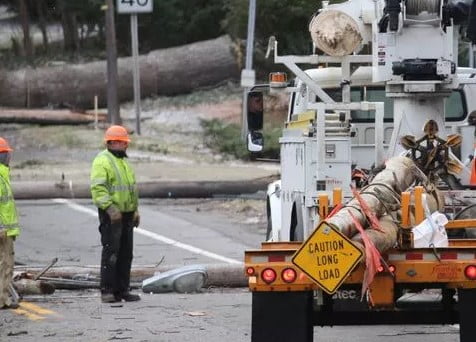Tips: Have a Public Communications Plan for Long-term Power Outages

Utility workers clean up downed power lines and debris after wind gusts reaching 80 mph swept through Monroe County, New York and surrounding areas in March 2017. Photo courtesy of Monroe County Emergency Management.
Long-term, widespread power outages can cause a plethora of unexpected communications challenges. IBTS spoke with Monroe County, New York, Emergency Manager Tim Kohlmeier about his experiences communicating with stakeholders and his constituents after a severe wind storm — coupled with sub-zero temperatures — hit the county in March 2017, causing multi-day power outages for more than 125,000.
Below are Kohlmeier’s tips for other localities based on the lessons learned from his own experiences.
Separate your agency’s communications from the utility’s.
- Avoid talking about power restoration times or the utility company’s efforts on camera. Instead, direct all questions regarding restoration to the utility company.
Ensure the utility company is present at press conferences.
- Avoid taking the blame for restoration complications or providing inaccurate answers to questions outside your expertise by having a representative from the utility company on-hand to field questions.
Partner with local elected officials.
- Residents want non-stop updates, and tensions can rise quickly if restoration takes longer than expected – constant communication from all levels of the locality is a must. “Our county executive was present throughout the event,” Kohlmeier explains. “Her social media platform, coupled with emergency management’s social media, worked very well.”
Live stream press conferences on your agency’s Facebook page.
- Constituents can have access to details provided throughout the entire press conference, as opposed to the short clip shown on the evening news. Likewise, residents without power don’t have television access.
- Live streams are also archived on Facebook, so residents without immediate access can watch at a later time.
Make sure your 911 center and staff are prepared for a high call volume.
- During power outages and high-wind events, thousands of residents will call in to report damage; be prepared to call in extra staff, and make sure your phone system can handle the surge in call volume.
- Emergency calls – car accidents, heart attacks, house fires – don’t stop during a power outage, and will likely increase. Make sure all 911 dispatchers are trained to track calls with pen and paper by hand.
Consider the impact of the power outage against the current environmental conditions.
- Provide guidance to the community based on conditions, such as severe cold or heat, to avoid injury resulting from using potentially dangerous equipment to keep warm or cool. “On day two we put out information on ‘hardening your home,’ like leave water dripping, create a tunnel to the bathroom, don’t run a generator in a closed building,” Kohlmeier recalls.
